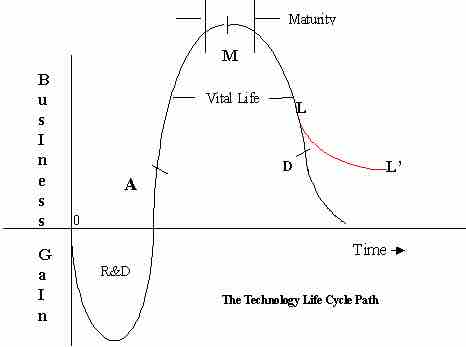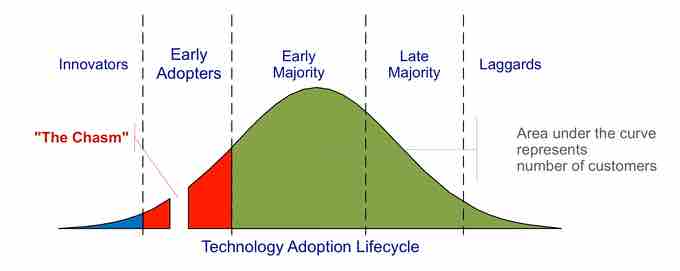The technology life cycle (TLC) describes the costs and profits of a product from technological development phase to market maturity to eventual decline. Research and development (R&D) costs must be offset by profits once a product comes to market. Varying product lifespans mean that businesses must understand and accurately project returns on their R&D investments based on potential product longevity in the market.
Due to rapidly increasing rates of innovation, products such as electronics and pharmaceuticals in particular are vulnerable to shorter life cycles (when considered against such benchmarks as steel or paper). Thus TLC is focused primarily on the time and cost of development as it relates to the projected profits. TLC can be described as having four distinct stages:

Technology life cycle chart
This chart illustrates the stages in the technological life cycle.
- Research and Development - During this stage, risks are taken to invest in technological innovations. By strategically directing R&D towards the most promising projects, companies and research institutions slowly work their way toward beta versions of new technologies.
- Ascent Phase - This phase covers the timeframe from product invention to the point at which out-of-pocket costs are fully recovered. At this junction the goal is to see to the rapid growth and distribution of the invention and leverage the competitive advantage of having the newest and most effective product.
- Maturity Stage - As the new innovation becomes accepted by the general population and competitors enter the market, supply begins to outstrip demand. During this stage, returns begin to slow as the concept becomes normalized.
- Decline (or Decay) Phase - The final phase is when the utility and potential value to be captured in producing and selling the product begins dipping. This decline eventually reaches the point of a zero-sum game, where margins are no longer procured.
Product development and capitalizing on the new invention covers the business side of these R&D investments in technology. The other important consideration is the differentiation in consumer adoption of new technological innovations. These have also been distributed into phases which effectively summarize the demographic groups presented during each stage of TLC:

Technology adoption life cycle
This adoption chart highlights the way in which consumers embrace new products and services.
- Innovators - These are risk-oriented, leading-edge minded individuals who are extremely interested in technological developments (often within a particular industry). Innovators are a fractional segment of the overall consumer population.
- Early Adopters - A larger but still relatively small demographic, these individuals are generally risk-oriented and highly adaptable to new technology. Early adopters follow the innovators in embracing new products, and tend to be young and well-educated.
- Early Majority - Much larger and more careful than the previous two groups, the early majority are open to new ideas but generally wait to see how they are received before investing.
- Late Majority - Slightly conservative and risk-averse, the late majority is a large group of potential customers who need convincing before investing in something new.
- Laggards - Extremely frugal, conservative, and often technology-averse, laggards are a small population of usually older and uneducated individuals who avoid risks and only invest in new ideas once they are extremely well-established.
Taking these two models into consideration, a business unit with a new product or service must consider the scale of investment in R&D, the projected life cycle the technology will likely maintain, and the way in which customers will adopt this product. By leveraging these models, businesses and institutions can exercise some foresight in ascertaining the returns on investment as their technologies mature.